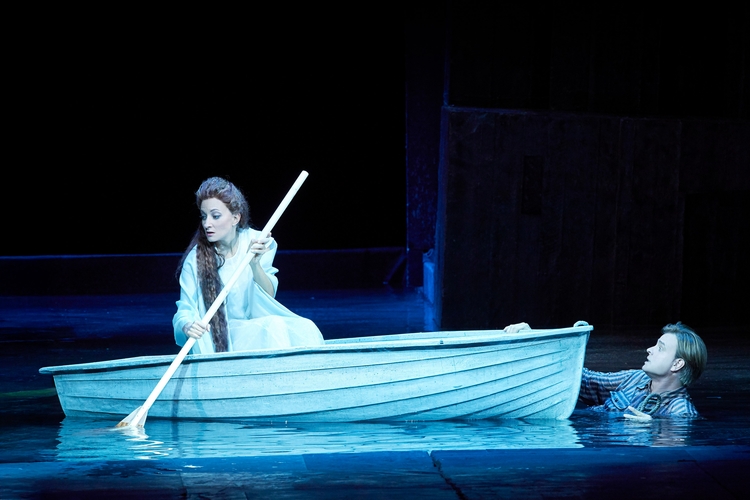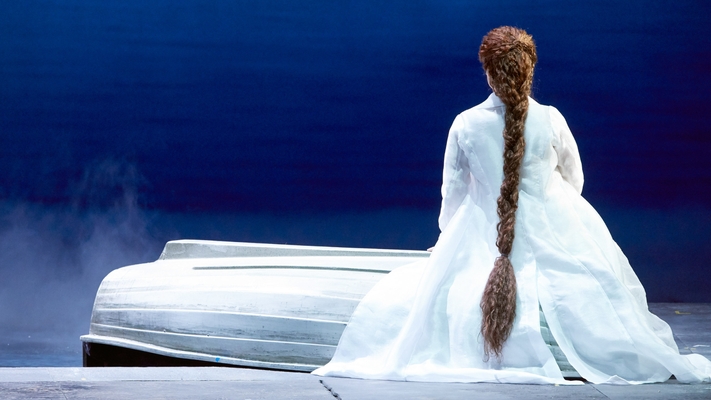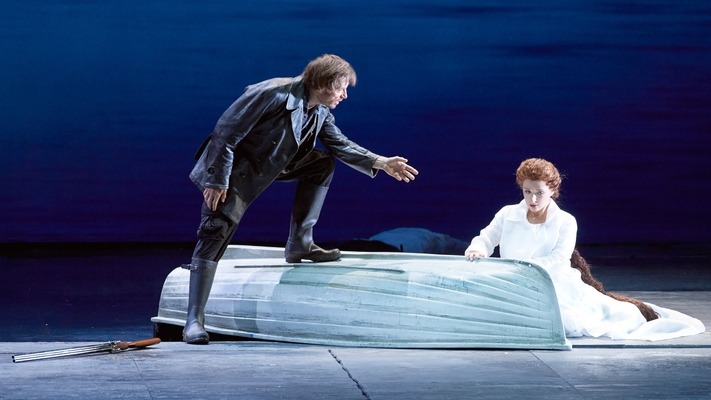Vague water
News |
Pelléas et Mélisande is a solitaire in the history of opera, a wondrous and mysterious work that conjures up a theatrical world all of its own. Multi-layered and magical, speaking in riddles and symbols, a complex study of relationships unfolds in a rare unity of language, sound and idea. To mark the revival of the highly acclaimed premiere production from 2017, we present the composer, work and performance in ten steps.
Who was Claude Debussy?
His colleagues sometimes called him the "Prince of Darkness" and he was undoubtedly a disturbing contemporary at times: the French composer Claude Debussy. Born in 1862, he did not come from a musical family and was not a typical child prodigy. He did not feel at home at the renowned Paris Conservatoire - many things there seemed too traditional and conventional to him; his style was also criticized by some as too progressive and unusual.
Nevertheless, he won the conservatory's famous Rome Prize on his second attempt in 1884, which enabled him to study at the Villa Medici in the "Eternal City". However, Debussy was not happy there either and left the city prematurely. For a time, he worked as a house pianist for Nadezhda von Meck, Tchaikovsky's patron. at the Paris World Exhibition in 1889, he became acquainted with Far Eastern music, which fascinated him.
In conversation with his alter ego "Monsieur Croche", or "Mr. Eighth Note", he wrote notes on musical events. In 1894, he achieved a milestone in music history with Afternoon of a Faun, which had a decisive influence on the musical perceptions of his time. His Nocturnes made him known to a large audience; in 1902 his only completed opera Pelléas et Mélisande was premiered, in 1905 the symphonic sketches La Mer - one of Debussy's best-known and most-performed works to this day.
He was honored, made a Knight of the French Legion of Honor and a member of the Paris Conservatoire's highest council. For many, he remained unapproachable and his private life repeatedly caused public uproar. he died of cancer in 1918; due to the First World War, his death was hardly noticed by the public.
Who was Maurice Maeterlinck?
According to his own statements and those of his partner, the singer Georgette Leblanc, Maurice Maeterlinck was extremely unmusical. Nonetheless, his works served as models for numerous composers, and Maeterlinck was even one of the most frequently set playwrights of his time. Born in Ghent, Belgium, in 1862 (the same year as Debussy), Maeterlinck was originally destined for a career in law, but he ventured into literature and achieved such great success with his first drama La Princesse Maleine that he quickly became one of the best-known representatives of Symbolism. He achieved world fame with his Blue Bird at the latest and was also awarded the Nobel Prize for Literature in 1911. He died in 1949 and had yet to experience the gradual fading of his fame. His play Pelléas et Mélisande was first performed in Paris in 1893.
Symbolism
As a leading representative of Symbolism, Maeterlinck was not interested in an exact reproduction of reality or an exact description of human existence. He wanted to show an image of man, embraced and guided by the forces of nature, at the mercy of the influence and arbitrariness of unknown powers, always in dialog with the undisplayable and invisible. The ambiguous and ambivalent dominated. The inner layers of existence, the interweaving with the metaphysical, the enigmatic and the mysterious connections between things were decisive. And, of course, the symbols: Water and light, gold and silence, nature and darkness - all of these had narrative expressiveness. "Symbolism emphasized the power of the unconscious, the sensuality of instincts, the delicacy of the soul, the dark sides of life, the imaginary in changing forms" (Konrad Paul Liessmann).
What is Pelléas et Mélisande about?
Arkel, the king of Allemonde, has two grandsons: Golaud and Pelléas. When Golaud once lost his way, he met the mysterious Mélisande and married her. But Mélisande suffers from the oppressive darkness in the kingdom of Allemonde. She and Pelléas, Golaud's younger brother, are attracted to each other and finally confess their love. Driven by jealousy, Golaud surprises them, kills Pelléas and injures the pregnant Mélisande. After the birth of her child, she dies without revealing the last truth about her relationship with Pelléas to Golaud.
The genesis of the opera
maurice Maeterlinck's play Pelléas et Mélisande was published in 1892 and premiered a year later - Debussy attended this performance. He planned to turn the play into an opera and received permission from Maeterlinck, including permission to shorten the text. the composition was provisionally completed in 1895, but numerous revisions were made before the premiere in 1902. in 1897, Debussy gave a private performance of the opera at the piano in front of friends and also took on all the vocal parts. He later fell out with Maeterlinck, who tried to give the role of Mélisande to his partner Georgette Leblanc. When this was unsuccessful, he declared his work disfigured by Debussy's cuts and tried unsuccessfully to prevent a performance. At the dress rehearsal of Pelléas et Mélisande on April 27, 1902, there were tumultuous protests from the audience. The premiere itself took place three days later; the opera's success only gradually materialized.
The music
"Music begins where the possibilities of language end; it is made for the inexpressible; I want it to appear as if it is emerging from a shadow and that it occasionally returns there." And: "I will not follow the errors of musical theater, where the music brazenly dominates; where poetry is relegated to second place, suffocated by too thick a musical veneer." These are two well-known statements by the composer about the nature of his musical language, and both are applicable to Pelléas et Mélisande. At a time in which Debussy regretfully saw the mysterious and the mysterious on the decline, the work of art, especially music, was for him still the bearer of the enigmatic. This is why the intuitive is one of the defining moments of his work: as if by magic, the impression of an experienced natural spectacle, such as the sound of the sea, is transformed into musical expression - something that can hardly be comprehended intellectually.
Debussy consciously turned away from traditional forms such as the Italian number opera or Wagnerian music drama, even though there is no doubt that Wagner's Tristan und Isolde and his Parsifal left their musical imprint in Pelléas et Mélisande. Strongly oriented towards French linguistic melody, Debussy's Pelléas music follows its own laws and establishes new rules. It is a turning point in the treatment of sound, in dealing with a new freedom and a depiction of the unspeakable. The unfathomable nature of the plot is reflected in the apparent vagueness of the music. It was not for nothing that the composer and conductor Pierre Boulez spoke of an instability in the music that could be perceived for the first time - an instability that represents the typical feeling of modernity.
Debussy and Impressionism
Debussy's music is repeatedly labeled impressionistic. He himself vehemently rejected this attribution. The attempt to depict nature as realistically as possible without concealing the craftsmanship of art contradicted his artistic intentions. Simply tracing an impression (of nature) seemed too little to him. "Impressionism usually means something blurred, unfocused, something random. And that doesn't fit! Debussy knew exactly how Pelléas and Mélisande should emphasize their words, he had the exact expression of the music precisely in his ear. There are perhaps impressionistic colors at play, although impressionism also had many different forms, but the music is not impressionistic per se." (Alain Altinoglu)
How do you approach Debussy's music?
Kate Lindsey: "As I'm singing my first Mélisande this time, I'm learning a lot in preparation for this role. I am concentrating heavily on the comprehensibility of the text. For Debussy himself, this was of the utmost importance: for this reason, he rarely lets the vocal lines run over each other. In terms of compositional and theatrical practice, he saw no point in having singers sing at the same time in view of the clarity of the text. So for me, the text comes first, and I work very intensively on it. However, the music, with its frequent changes of meter and complex keys, is also a particular challenge. The preparation for Debussy is therefore extremely demanding and time-consuming, requiring enormous concentration. But it's worth it! The more I immerse myself in this score, the more I realize what a masterpiece Pelléas et Mélisande is."
The staging
The staging of the current production is by Marco Arturo Marelli, who has directed numerous works for the Vienna State Opera. He is currently the only living director to hold the highest state opera award, honorary membership. The defining element of the stage space, also designed by Marelli, is a large water landscape. According to Marelli, "the calm flowing along, the pauses or sudden stops, the eddies on the deceptive surface, the invisible and dangerous currents in the depths, the refraction of light and dark as well as the abyss of bottomless darkness in Debussy's musical language" speak for this. And further: "For me, water is also an image of the haunting of the repressed, of unknown, impending catastrophes. It is the medium of dreamlike perception."
Ljubiša Tošić wrote about his highly acclaimed Pelléas work in the Standard: "Marco Arturo Marelli is of course also a virtuoso of haunting images that allow themselves a touch of abstraction in order to always be open to small irritations and metamorphoses, whose meaningfulness is combined with visual magic. The castle, in which scenes resembling a family constellation take place, is a symbol of hopelessness and of being trapped, even in a diffuse premonition of death. At times, however, this spatial harshness shines in the light of fleeting hope: water in particular becomes the illuminating element that also corresponds visually with the sound poetry of this opera. However, Marelli's director does not hide the brutal, ultimately lethal aspects of this work behind artificial kitsch symbolism. The boat trip of Mélisande and her Pelléas, who pulls her through the water, has shy traits of a tenderness that is never directly lived out. However, the production draws quasi-realistic conclusions from Golaud's explosive emotional turmoil and his jealousy-fueled frenzy."


